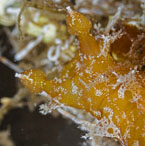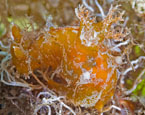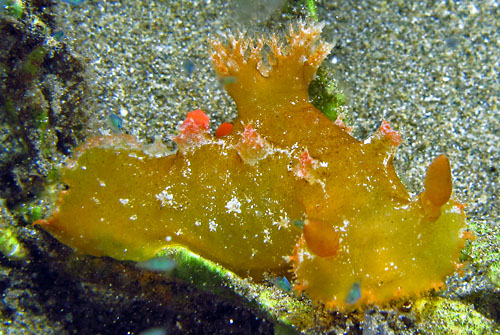| Home |
| Acknowledgments |
| Conventions |
| Glossary |
| Maps |
| References |
| Links |
| Articles |
| Thumbnails |
| Species
list |
| Family |
| Next
species |
Additional Photos

detail

branchia

oral veil

rhinophore detail

lateral spots

more white

Plocamopherus cf. imperialis Angas, 1864

| Maximum size: about 35 mm. Identification: This is a mustard-yellow animal minutely flecked with brown. There are clusters of white flecks on the papillae, branchia and (sometimes) rhinophores. Reticulate white patches may be present on the notum and the sides of the foot are decorated with small orange-brown spots. There are three pairs of enlarged, pink-tipped papillae on the sides of the notum with the posterior pair having greatly inflated, hemispherical tips. There is a tall dorsal crest on the posterior portion of the notum that is fringed with fine papillae. Natural history: Plocamopherus cf. imperialis is known from half a dozen animals found crawling on sand at night and in early morning at 5-8 m (17-25 ft) in a Halimeda kanaloana bed. The hemispherical tips on the posterior lateral papillae are probably bioluminescent and it can swim by lateral flexing if disturbed. (Note 1) Distribution: Maui: Plocamopherus imperialis is known from New South Wales and New Zealand with related animals in Japan and elsewhere. Taxonomic notes: The over-all form and color are similar to some photos of P. imperialis from elsewhere in the Indo-Pacific. But, there's enough uncertainty regarding which animals are included in that species that we've opted to use "cf." It was first recorded in Hawaii from Maalaea Bay, Maui by Katherine Shepherd on Dec. 16, 2012. Photo: Katherine Shepherd: about 35 mm: Maalaea Bay, Maui; Dec. 16, 2012. Observations and comments: Note 1: Katherine stated that she observed it attempting to swim in the field. |
| Thumbnails |
Species
list |
Family | Next species | Top |